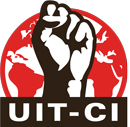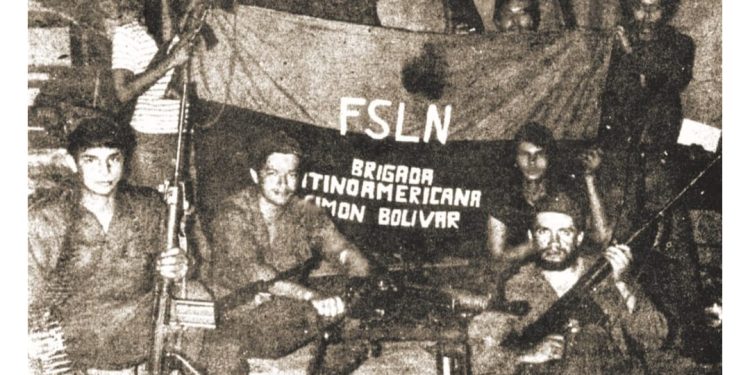Plástico from the album Siembra (1978) by Rubén Blades and Willie Colón, is a sharp hymn against superficiality and materialism. The song is super salsa, but also a scathing critique of the frivolity of a society obsessed with appearances, where ‘everything superficial’ crumbles as soon as it is put to the test. But towards the end, the song takes a turn: a list of Latin American countries that breaks with the initial irony and becomes an ode to the diversity and cultural richness of the region. This is repeated in several songs on the album.
Panama (present!)
Puerto Rico (present!)
Mexico (present!)
Venezuela (present!)
Peru (present!)
Dominican Republic (present!)
Cuba (present!)
Costa Rica (present!)
Colombia (present!)
Honduras (present!)
Ecuador (present!)
Bolivia (present!)
Argentina (present!)
Nicaragua without Somoza (present!)
The neighbourhood (present!)
The corner (present!)
Let’s go to the interviewee.
The US intervention did not end with the overthrow of Somoza. On the contrary, Washington redoubled its efforts to destabilise the new revolutionary government. Support for the Contra’s, armed counter-revolutionary groups financed and trained by the CIA, sparked an internal conflict that left thousands dead and aggravated tensions in the region. Through economic blockade, disinformation and sabotage, the US tried to suffocate the Sandinista dream and send a clear message to other social movements in Latin America: political transformation would come at a high cost.
I was a militant and leader of the Trotskyist left current led in 1979 by our founder Nahuel Moreno, who was in exile in Colombia. From there, together with the Colombian comrades of the PST (Socialist Workers Party), an international call was made. The brigadistas were Colombians, Panamanians, Mexicans, Argentinians, Costa Ricans, with different political formations. We Trotskyists were in the minority. The aim was to provide concrete solidarity with the fall of Somoza.
The Somoza dictatorship was a regime inherited from father to son, from ‘Tacho’ to ‘Tachito’, and it lasted about 50 years. This ongoing revolutionary process combined the armed struggle of the Sandinista National Liberation Front with a growing mass insurrection.
From 1978 onwards, there was a general strike that significantly weakened Somoza’s dictatorial power. This led to the collapse of the regime, and even US imperialism itself decided to let go of his hand when it realised that it could no longer sustain him. On July 19th 1979, Somoza finally fell.
The military preparation, as in any civil war, was minimal due to the ‘urgency of the fighting and the need for combatants’. This is common in this type of conflict. In Costa Rica, training included the basics: weapons handling and reconnaissance of the terrain where we were going to act.
Each person arrived with a different background; in my case, I had done my military service. There were preparation camps. For example, in the area where I was deployed, the Atlantic coast, in the port of Limón, in Costa Rica, we had a training camp with around 70 combatants of different nationalities; there was even a young German. This place was similar to the Atlantic area of Nicaragua, specifically similar to the region of the port of Bluefields, which we would later take over together with the local Sandinista armed group. It is a jungle area called the Mosquito Coast.
Participation was open. There was great sympathy with the Brigade’s combatants. In our case, we were involved in the seizure of the port of Bluefields, a strategic location on the Atlantic coast of Nicaragua. We first went to Bluff Island, where an autonomous Sandinista group of Afro-descendant origin was already present. This was because, both on the Nicaraguan Atlantic coast and in Costa Rica, African descendants, brought over as slaves, predominated. In this region they even speak their own English dialect. We were received en masse by the population. When the National Guard surrendered, we disembarked in the city of Bluefields.
Upon entering the city, we marched, and quickly took control, as the Nicaraguan people supported the revolution. In the case of Bluefields, and also in Managua, we contributed to the building of trade unions and the formation of neighbourhood militias. The revolution brought rapid changes: although there had been a previous general strike, the trade unions were dominated by the dictatorship’s apparatus. After the triumph of the revolution, new company unions emerged, organised in assemblies.
For example, in Bluefields there was no trade union and we managed to form 12 unions in a few days. In a city with a population of about 25 or 30 thousand inhabitants. It was a very important port city. You have to take into account that Managua, at that time, had 500,000 inhabitants in a country of 2.5 million people in 1979. The brigade managed to form more than 120 trade unions throughout Nicaragua. The sympathy for the brigade was so strong that in union plenaries and assemblies petitions were signed to the government to grant Nicaraguan nationality and citizenship to brigade members.
Yes, exactly, it was very important and that was our policy of unity. Although we always maintained criticisms and differences with the Frente Sandinista because, from the outset, we made it clear that we did not agree that the triumph of the revolution should lead to a shared government with bourgeois sectors. This, unfortunately, was what happened, taking shape in the figure of Violeta Chamorro, who represented a conservative opposition to Somoza and ran the newspaper La Prensa.
Despite this, our policy was not sectarian. We always called for unity and promoted the participation of all the left forces, not only Trotskyists, but also anti-imperialists in general, to form a movement of solidarity with the revolution to overthrow the Somoza dictatorship. This involved not only fighting on the ground, but also articulating actions in every country in the region. It was a positive effort.
When the revolution triumphed, a process of hostility towards the brigade began on the part of the government led by Daniel Ortega and Violeta Chamorro. This culminated in the expulsion of our brigade, as they did not accept critical voices. In fact, this was the first repression in Nicaragua after the fall of Somoza, which was regrettable.
More than 40 years later, we find that Daniel Ortega, who had been one of the main leaders of the revolution, now heads a new bourgeois dictatorship. He has even persecuted and repressed his own former comrades of the revolution, under a false halo of leftism. The saddest case is that of the former commander Dora Tellez, who was imprisoned and then expelled from the country, under the accusation of ‘traitor to the homeland’. She was a heroine of the revolution when she was only 21 years old and led the insurrection in the city of León.
Yes, I think there would be two main memories, apart from the fact that I had the privilege of having participated in a historic revolution for Latin America. What struck me most was our role in the formation of the independent government, without bourgeois political members, in the port of Bluefields. Together with the regional Sandinista group I mentioned, we arrested the Somocista mayor and the officers of the National Guard, imprisoned them and took over the barracks. Every day, at 5 o’clock in the morning, we did military training together with the Sandinista comrades and we raised both the Nicaraguan flag and the Sandinista flag. It was a really impressive moment.
The second significant event occurred later, when the revolution decreed the expropriation of Somoza’s companies, many of which were associated with US companies. One of those companies was in Bluefields, on one of the islands, and it was the Booths fishing factory, which packaged prawns, among other products that were exported to the United States. In that context, I was in charge of carrying the expropriation decree, as I had travelled to Managua and returned to Bluefields with that document.
For me, these are unforgettable revolutionary events. I did not experience them as individual achievements, but as part of the triumphs of the workers’ and people’s revolution and the collective work of the Simon Bolivar Brigade.
Unfortunately, in concrete terms, there is nothing left, because everything was destroyed by the Sandinista Front itself, which allied itself with the bourgeoisie, even with pro-American sectors. Today there are no freedoms; the jails are full of prisoners, we are still demanding the appearance of the journalist Fabiola Tercero, and the democratic and social gains have been lost. This reflects the central problem of the Revolution, and that is why we were confronted and repressed by Sandinismo. The Simon Bolivar Brigade proposed to advance to socialism and break the pact with Violeta Chamorro and the bourgeoisie.
The Sandinista leadership headed by Daniel Ortega, at that time influenced by Fidel Castro, Castroism and reformism, decided not to move towards socialism, despite the fact that the conditions for doing so existed in Nicaragua. This led them to move steadily backwards, moving towards an increasingly dictatorial regime.
What remains, and cannot be erased, is history. History does not disappear. There are still people, some younger, some less, who participated in the process and know it. This idea of the Revolution will be taken up again. We revolutionary socialists have confidence in that. We trust in the Nicaraguan working people and the masses, that sooner or later they will raise those banners again. The traitor and dictator Daniel Ortega will also come to an end.
I returned clandestinely that same year to rejoin the PST. I returned in that way because at that time the Videla dictatorship was in force in Argentina. The PST and our Morenist Trotskyist current continued to spread the triumph of the fall of Somoza and the experience of the brigade because, at that time, dictatorships predominated in South America. The fall of Somoza represented a change that helped us to strengthen the struggle against dictatorships in South America, in countries like Brazil, Argentina, Uruguay and Chile. This revolutionary victory had an impact and helped the masses to acquire the strength to confront and finally defeat these regimes.
It is always important to read or listen to history in the voice of its protagonists, especially when talking about worlds that seem as far away as the Sandinista Revolution. I hope you enjoyed this interview as much as I did, and that you liked the photos, which are from Miguel Sorans’ personal archive.













